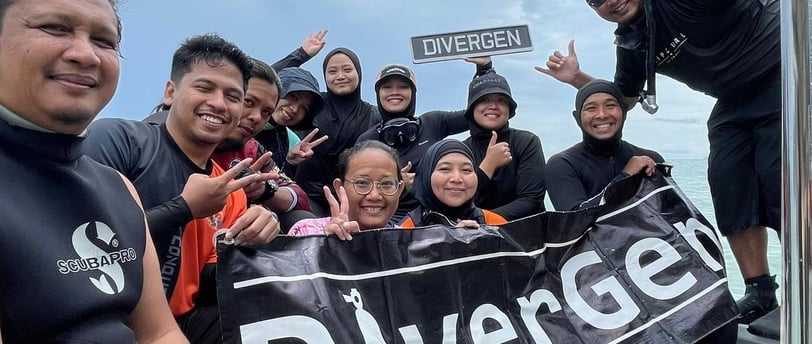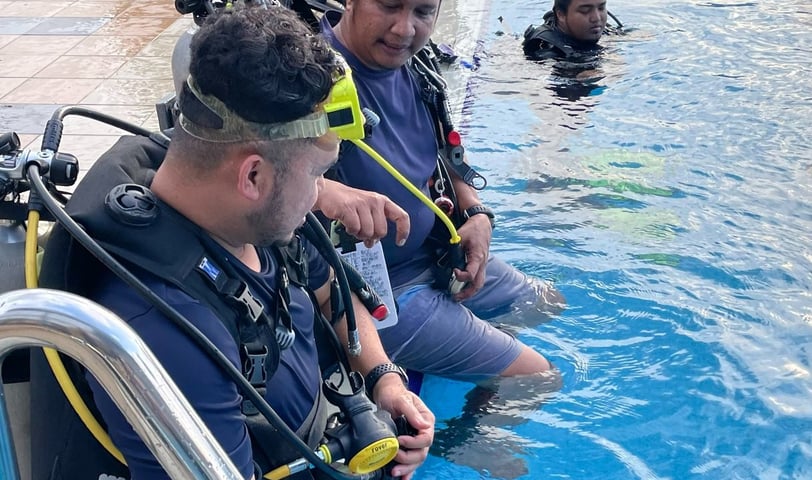Dive into Open Waters: Your First Ocean Adventure
Embarking on your first open water scuba diving experience is an exciting milestone! While pool training is essential, nothing beats the thrill of diving into the vast ocean.
DIVE JOURNEY
Author: DiverGen
7/31/20244 min read


Getting Started: Transition from Pool to Ocean Diving
Embarking on your first open water scuba diving experience is a thrilling milestone in your diving journey! While pool training is a crucial foundation, transitioning to the vast and dynamic ocean environment introduces new challenges and excitement. This guide will walk you through essential steps to ensure a smooth and enjoyable shift from the pool to open water. With the right preparation and mindset, you'll dive with confidence and relish every moment of your underwater adventure.
Preparing Your Gear
Check Your Equipment
Before you dive into the ocean, it’s vital to ensure your gear is in excellent condition. This preparation includes inspecting your mask, fins, and wetsuit for any wear and tear. Check for cracks, tears, or signs of damage that could affect performance underwater.
Regulator and BCD
Your regulator and Buoyancy Control Device (BCD) are crucial for a safe dive. Make sure your regulator is functioning correctly, with no leaks or issues. Your BCD should be in good working order, with all inflator and deflator mechanisms operational. Test your equipment by assembling and disassembling it to ensure everything works smoothly.
Additional Gear
Consider packing a dive knife for safety, a surface signaling device to communicate your position, and an underwater camera if you want to capture the beauty of marine life. Having a checklist can be invaluable to ensure you don’t forget any essential items before heading to the dive site.
Understanding Dive Conditions
Check the Environment
Unlike the controlled environment of a pool, ocean conditions can vary greatly. It’s crucial to check the weather, tide, and current forecasts before your dive. Understanding these conditions helps you plan your dive effectively and avoid unexpected challenges.
Water Temperature
Water temperature can fluctuate significantly based on location and depth. Be prepared with the appropriate thermal protection, such as a thicker wetsuit or a drysuit, depending on the conditions. A comfortable diver is a happy diver, so ensure you’re suited up appropriately.
Visibility
Visibility underwater can vary from crystal clear to murky. Be prepared for different levels of underwater clarity and adjust your dive plan accordingly. Knowing what to expect helps you remain calm and adapt to changing conditions.
Navigating Your First Dive Site
Familiarize Yourself
Arriving at a new dive site can be both exhilarating and overwhelming. Take a moment to familiarize yourself with the site layout, including entry and exit points. If possible, dive with an experienced buddy or a dive instructor who knows the area well. Their local knowledge can enhance your safety and enjoyment.
Buddy System
The buddy system is essential for safety. Stay close to your dive buddy and maintain open communication throughout the dive. Use hand signals to convey important information, and always keep an eye on your dive computer to monitor your depth and air supply.
Descend Slowly
When descending, do so gradually and equalize your ears frequently to avoid discomfort. A controlled descent helps you acclimate to the pressure changes and ensures a safer start to your dive.
What to Expect Underwater
Marine Life
Once underwater, you’ll be greeted by a stunning array of marine life. From vibrant coral reefs to schools of colorful fish, there’s much to explore. Take the time to appreciate the beauty around you, but remember to respect the underwater environment.
Respect Marine Life
Avoid touching or disturbing marine creatures. Maintaining a respectful distance helps protect the ecosystem and prevents harm to both you and the marine life. Additionally, be mindful of your buoyancy to avoid damaging delicate coral reefs and habitats.
Buoyancy Control
Mastering buoyancy is key to a successful dive. Practice using your BCD and fine-tuning your buoyancy through breathing techniques. Neutral buoyancy helps you conserve energy and air, allowing for a longer and more enjoyable dive. Regularly adjust your buoyancy to stay comfortably suspended in the water column.
Safety First
Always prioritize safety. Keep a close watch on your dive computer to track your depth, time, and nitrogen levels. Regularly check your air supply and stick to your dive plan. If you ever feel uncomfortable or encounter any issues, signal your buddy and ascend slowly to the surface.
Embrace the Adventure
Transitioning from pool to ocean diving is an incredible adventure, marked by new experiences and challenges. With proper preparation and a sense of adventure, you’ll be ready to explore the depths with confidence. Remember, every great diver started with the basics, and each dive is an opportunity to learn and grow.
Join Us at DiverGen
Ready to dive into your underwater journey? At DiverGen, we’re passionate about helping divers of all levels explore the ocean’s wonders. Whether you’re preparing for your first open water dive or looking to advance your skills, our expert instructors and supportive community are here to guide you every step of the way.
Dive into an unforgettable experience with DiverGen, where adventure awaits beneath the waves. Explore new depths, connect with fellow divers, and discover the thrill of scuba diving with confidence. Visit our Dive Log Blog for more tips and insights, and join us for your next diving adventure. The ocean is calling—let’s answer it together!


Explore
Premier provider of scuba diving experiences and professional courses.
Passion
Ocean
diverlogyventures@gmail.com
+6012-2234432
© 2024 Diverlogy ventures (NS0302402-A) . All rights reserved.

